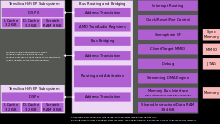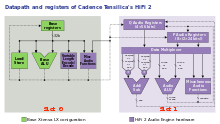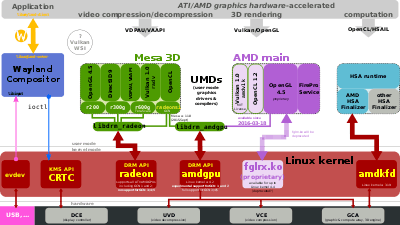AMD TrueAudio
 | |
| Design firm | Advanced Micro Devices |
|---|---|
| Introduced | October 2013 |
| Type | audio acceleration |


TrueAudio is the name given to AMD's ASIC intended to serve as dedicated co-processor for the calculations of computationally expensive advanced audio effects, like e.g. convolution reverberation effects and 3D audio effects. TrueAudio is integrated into some of the AMD GPUs and APUs available since 2013.
Overview
TrueAudio is a DSP for audio based on Cadence Tensilica HiFi EP DSP with Tensilica Xtensa SP float support.[1]
AMD claimed that a few simple audio effects can use up to 14% of the CPU. Audiokinetic claimed that it is up to 10%.[2] Independent software vendors (ISV), such as game developers, can use what is called a Wwise audio plugin to offload such computations to the TrueAudio DSPs. The on-die TrueAudio DSPs provide a better "silicon area to computing power" ratio and "power consumption to computing power" ratio for audio processing than the CPU, effectively making it an audio acceleration unit. Any additional benefits of the TrueAudio DSPs, such as "better effects", have been severely criticized.[3]
It may be noteworthy that Unified Video Decoder is another ASIC by AMD which is also based on Tensilica's Xtensa, and that Tensilica is member of the HSA Foundation.
In 18 March 2014, AnandTech evaluated AMD TrueAudio using the Thief video game.[4]
True Audio Next
A new version of TrueAudio, TrueAudio Next, was released with the AMD Radeon 400 series GPUs. TrueAudio Next utilizes the GPU to simulate audio physics.[5] The move from a dedicated DSP to GPGPU breaks compatibility with the previous TrueAudio implementation.[6] The TrueAudio Next SDK was released as open source through AMD's GPUOpen suite in August 2016.[7] It also clarified that TrueAudio Next uses the GPU's ray-casting technology to do the audio computation, and can also reserve GCN compute units for lower latency. Support for True Audio Next was added to the beta Steam Application programming interface in February 2018.[8]
Software support


AMD TrueAudio enables dedicated digital signal processing (DSP). Such dedicated audio processing horsepower is specifically for generating immersive soundscapes and saves CPU cycles that can be used for other game processing tasks such as AI and Physics.
The video games Murdered: Soul Suspect, Star Citizen, Thief and Lichdom: Battlemage (uses CryEngine) can be configured to use AMD TrueAudio if present.
There is an audio plug-in for Audiokinetic's Wwise (Wave Works Interactive Sound Engine) to off-load computation to the TrueAudio DSP(s). Wwise is available for Linux, OS X, Windows, PlayStation 4, Xbox One et al.
GenAudio's AstoundSound, a highly optimized collection of advanced DSP C/C++ software available as a library or a plugin for augmenting real-time audio engines on Linux, OS X, Windows as well as Android and iOS, can make use of AMD TrueAudio.[9] AstoundSound is also wrapped for several plug-in formats, such as RTAS and Wwise and has been integrated into several DSP chips. AstoundSound is described as fully programmable audio engine.[10][11] As of July 2014 there are no news regarding products supporting TrueAudio and LV2.
- Tuscany AstoundSound on YouTube – special version of "Tuscany" VR demo from Oculus VR; AMD TrueAudio is utilized to calculate the spatialization of an audio environment. Spatialization is a technique that permits the audio engine to create a fully 3D soundfield on a stereo headset. This effect is powered by the positional 3D audio plugin "AstoundSound 3D RTI" (real-time interface) by GenAudio, and it includes support for elevation, distance and positioning. AstoundSound is e.g. integrated with the FMOD Studio.
Driver support
AMD has retired AMD TrueAudio Technology support with Radeon Software Crimson Edition 16.40 and introduced a new way for developers to support AMD TrueAudio Technology like features with AMD TrueAudio Next. More information on TrueAudio Next can be found at http://gpuopen.com/gaming-product/true-audio-next/.
Availability
AMD TrueAudio is found on-die of select AMD graphics cards and APUs. A die can house multiple AMD TrueAudio DSP cores, each having 32KiB instruction and data caches and 8KiB of scratchpad memory for local operation.[12]
AMD TrueAudio SIP blocks are found on the dies of some GPUs of the AMD Radeon Rx 200 Series;[13] namely the Radeon R7 260, Radeon R7 260X, Radeon R9 285, Radeon R9 290, Radeon R9 290X and the Radeon R9 295X2, and in Kaveri and Carrizo-based APUs.[13] TrueAudio is also supported by the PlayStation 4 hardware.
See also
- Advanced Linux Sound Architecture – the Linux kernel sound subsystem
- E-mu 20K – the DSP found in Sound Blaster X-Fi sound cards
- SoundStorm – Nvidia audio hardware in nForce motherboard chipsets
- Aureal Vortex – dedicated chip for computation of audio effects
- Yamaha DSP-1
- FMOD – middleware for audio
Other AMD SIP blocks
References
- ↑ "Everything You Wanted to Know About AMD TrueAudio". Maximum PC. 2013-10-08. Archived from the original on July 11, 2014. Retrieved 2014-07-06.
- ↑ "Wwise Convolution Reverb with TrueAudio". 2013-11-21.
- ↑ "Do We Really Need AMD TrueAudio?". 2013-09-26. Retrieved 2014-07-06.
- ↑ "Evaluating AMD's TrueAudio and Mantle Technologies with Thief". AnandTech. 2014-03-18. Retrieved 2014-07-06.
- ↑ Stanley, Donny (29 June 2016). "Review: AMD Radeon RX 480 8GB – Polaris Finally Arrives!". Custom PC Review. Retrieved 1 July 2016.
- ↑ Shrout, Ryan (30 June 2016). "Podcast #406 - AMD RX 480 Review, Huawei MateBook, Steam Summer Sale, GTX 1060 and more!". PC Perspective. Retrieved 1 July 2016.
- ↑ Kampman, Jeff (17 August 2016). "AMD open-sources VR audio and video-acceleration SDKs". Tech Report. Retrieved 17 August 2016.
- ↑ Manion, Wayne (6 February 2018). "Latest Steam Audio SDK beta adds AMD TrueAudio Next support". Tech Report. Retrieved 6 February 2018.
- ↑ "AstoundSound for Gaming". 2013-11-21.
- ↑ "AstoundSound – 3D-Audio-Demo by Genaudio" (in German).
- ↑ "AstoundSound Homepage".
- ↑ "AMD A8-7600 Kaveri APU review - The Embedded GPU - HSA & hUMA". 2014-01-14.
- 1 2 "A technical look at AMD's Kaveri architecture". SemiAccurate. 2014-01-15.
- ↑ http://permalink.gmane.org/gmane.linux.alsa.devel/142480
- ↑ http://lists.freedesktop.org/archives/dri-devel/2015-July/086081.html